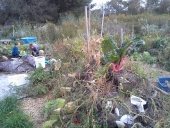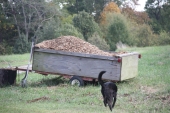posted 14 years ago
The black soil topic came up over in the perma-culture forum, so thought would bring over here since it is more of a community question.
Amazon basin is kinda famous for it's black soils. They dig it out of benches up on the sides of river banks, and is still super productive. Supposedly is in the planters at the Intl airport, and has become quite the bootleg item there.
It is very distinctive because of the charcoal content, and the pottery shards.
Is very hot debate about whether it is natural, a byproduct of garbage burn piles, or a intentional product.
The scale is tipping outside the Americas, (they are already convinced down there) that it IS a sanitation and farming project, because of some distinctive signatures of the soils.
Soils in rainforests are pretty barren because, well, it's a rainforest. Everything breaks down quickly, and nutrients are washed out pretty quick too. Natural depressions that collect forest duff, tend to get explosive growth from opportunistic plants, and then get shaded out, becoming mono or multistory pretty quickly too.
The folks that think is periodic flooding debris, or garbage burn piles, tend to say that 7-8k years ago, no one was doing agriculture, let alone civic sanitation.
This is not quite true, china was doing it at least 4k years ago. There is a great article written up about the "nightsoil boats", and a thriving economy built around it. Seems these guys would go around and distribute large pots (kinda like their vinegar pots) for free, then come around a couple times a week to collect the deposits, and give the folks a few cents for the trouble of using their service. These guys would then truk the carts down to the river, and load up boats of the pots, or fill larger onboard tanks. These boats would then haul the contents back out to the distributed farms, to the happy farmers, who would happily give a buck for the high quality fertilizer. Salaries would be distributed back up the tract, and everyone was happy. Then, of course the governments tried to take it over, and, well, you know how that went.
The distinctive thing about the Amazonian soils is that they appear to be "made".
The charcoal isn't from bonfires, but is actually bio-char - or activated charcoal. This has to be "made", it is fairly rare to find in nature, as the wood must be smootherd, or buried.
Another is the appearance, in ALL the places i have heard of, is the pottery shards.
To us desert dwellers, when we think of pottery shards, we imagine little triangle pieces, some displaying designs, and most being on the order of 1/2 to 1 1/2 inches on a side.
The ones down there are commonly called sherds, and are on the order of 1/16 to 1/4 in on a side. The folks argue that this is actually the result of smashing the pottery with poles, to pulverize it down to a size that is good for drainage and transport.
One thing they point too to bolster their argument is that the slash and burn technique down there, in contrast to other places, is the fact that after they go thru and cut and clear an area, they pile up the slash with the driest pieces on the ground, then haul in the newer stuff, actually smothering the fire down to make - you guessed it- biochar. They tend to feed these piles for up to a week or so, dragging in the green stuff to keep it smouldering, rather that starting new burn piles to burn it up.
The advocates theory that this was an active process is also that the soils in these "plots" is actually mixed, from a depth of a 1/2 meter, down to 3 meters! That these plots show sherds throughout the depth, and that it is activated charcoal, not the regular kind, the theory is further strengthened by the fact that not a single one of these plots has been found with layers. Any standard burn pile by indigenous pops show distinctive layers, whether it is shellfish, or yucca fibers and roots.
The theory now states that these guys would build up a latrine area of pots in a low lying area, that had lots of understory brush (the forest taking back over) and when they didn't want to fight it anymore, they would hack and slash, piling up the burn over the pots. Then everyone would pack up, they would wait for the dry season, light the forest, and high tail it out of there. Then they would rotate out to an earlier abandoned site, plant the old black soil areas, and break down the burnt over pots from (4-5?) years earlier, mix it with the charcoal, and pile it up to a height that equaled the tops of the new jars. Start stacking the newly filled jars next to each other, and farm till it was time to move again. Flies too bad, or the jungle taking over again.
Repeat.
cant find the link for the chinese story.
here is some background on the americas
http://www.ancientweb.org/
and a site at yahoo groups has lots of backstory on the black soils. think it was called ACS by the folks in the game.
Get involved -Take away the standing of corporations MovetoAmmend.org










